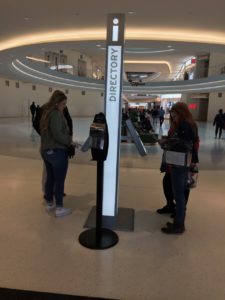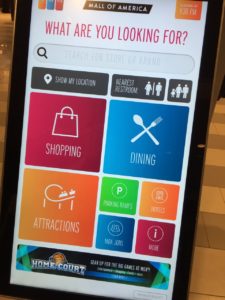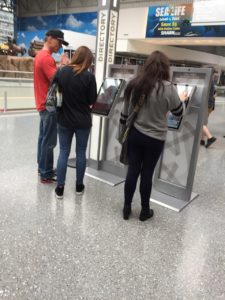
The Mall of America turned to small digital directories to solve a big wayfinding problem. Credit all photos: Paul Kapustka, VDR (click on any picture for a larger image)
Once upon a time, the Bloomington, Minn.-based Mall of America was no different from any other shopping mall when it came to directories. In what was somewhat of a shopping center tradition, the Mall of America had four-sided standalone structures with four-foot wide printed displays, crammed with maps and lists of locations. While big, printed directories may have been the way malls always did things, they didn’t fit in with the Mall of America’s recent moves to embrace digital technology to improve the guest experience.
“Those old directories were monstrosities, and they were obsolete the moment you printed them,” said Janette Smrcka, information technology director for the Mall of America. During a visit this spring by Venue Display Report to the Mall, Smrcka said attempts to put granular information on the printed maps – like stacked graphics showing the multiple oor levels close together – produced a mostly frustrating experience for guests.
“You had to walk around these things, and it was really difficult to find anything, because there are so many stores,” Smrcka said. “And the maps were kind of information overload. We found guests didn’t react well tothem.”
Going digital for directories
Editor’s note: This profile is from our most recent issue of our VENUE DISPLAY REPORT series, where we focus on telling the stories of successful venue display technology deployments and the business opportunities these deployments enable. This issue also contains profiles of the new big video board at Oracle Park in San Francisco, and an in-depth look at display technology at U.S. Bank Stadium during the Final Four! START READING the issue today!
For the technology-forward Mall of America – which installed a high-definition Wi-Fi network throughout the property a few years ago – digital touch-screen directories seemed a logical next step ahead. According to Smrcka, the generational shift to embrace more touchscreen devices like phones and tablets, and the emergence of similar devices in many public places like airports and restaurants has produced a public that is far more comfortable with touching a display.“Five or 10 years ago a touchscreen directory might have been too soon, but now very few people are hesitant [to use touchscreens],” Smrcka said. “Everything is a touchscreen, and people expect it. Everyone feels comfortable [using them].”
An important caveat for Mall of America, Smrcka said, was finding a way to make the mall directory experience more personal and private, like using an ATM.
“We always knew we wanted the screens to be smaller,” Smrcka said. Some other shopping centers that the Mall of America team had scouted had larger interactive displays, which Smrcka said could produce a “creepy” feeling since personal searches could potentially be viewed by people walking by.
“We felt like we wanted the screens to be a size where your body could be a shield,” Smrcka said. “Nobody needs to know what I’m looking for.”
As part of its deployment strategy, the Mall of America followed its agile development ethos and rolled out a small number of test units live in the Mall in late 2016. The displays, about the size of an iMac desktop screen tilted vertically, are from Aopen, and use a Chromebox commercial base for the operating system. A local Minneapolis-area wayfinding solutions firm, Express Image, provided the programming, and without much fanfare, the Mall flipped the switch and let its guests interact with the devices to see what happened.
Reducing search times to under a minute
“We didn’t exactly stalk people, but we did watch them [using the directories],” Smrcka said. Though some of the features enabled by the devices – like a search field – were obvious adds, exposing other services like maps and wayfinding weren’t as straightforward.
“There is a real problem of how do you logistically show 5 million square feet,” Smrcka said.
After watching users interact, the Mall of America has currently settled on a 2D mapping feature that can, if users choose it, show an animated path from where they are to where their desired destination is.“The focus is how quickly can we help guests find what they are looking for,” Smrcka said.
After pulling the trigger to roll out 100 of the directories in mid-2017, the Mall’s IT team was rewarded with extensive usage analytics, which they put into an immediate feedback loop to improve the directories’ feature list and what was shown to users first.
“By far, the number one search was for restrooms,” Smrcka said. The Mall took that information and now has a prominent button on the main screen that will quickly show users the closest restrooms to that spot.
“There’s nothing like that immediate need,” Smrcka sAaid. “That was a quick win.”
Analyzing more of the data helps the Mall’s IT team do a better job of predicting what users are looking for when they misspell store names, or if users are having difficulty with directions. According to Smrcka some data analysis showed that one physical location of a set of directories was causing confusion since “people told to take a left turn ended up inside a Cinnabon.” Moving the directories around the nearby corner helped improve the directions feature, she said.
The problem of how to show directions to places on different levels of the mall was solved by having a different screen for each level; the animated directions will even advance the pathways up and down escalators or stairways. Srmcka is also proud of the Mall’s desire to make information as real-time as possible; that effort includes a kind of “mall hack” where cheap power meters feed information into the directory system to let guests know if, say, an escalator is temporarily out of service.“Little things like that make a big difference,” said Smrcka.
In a casual mall walkaround, VDR observed many guests taking turns at the numerous directory locations, seeming to find what they need quickly without any obvious confusion. According to Smrcka, the directories have now logged more than 10 million interactions, with the average interaction time at 38.98 seconds.
Some features in the directories, like the ability for users to enter their phone number to get information via text message, may take longer to take off, Smrcka said. “There are always going to be some people who don’t have the comfort level to put their number into a public device,” Smrcka said. But overall, the small digital directories have added up to a huge success.









